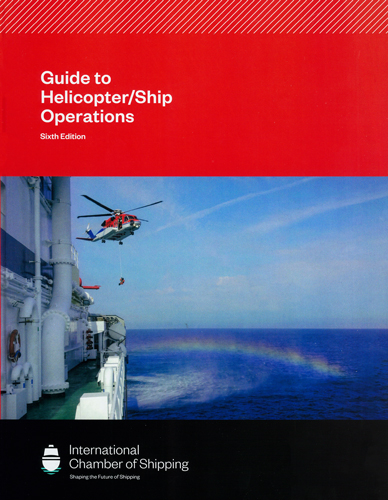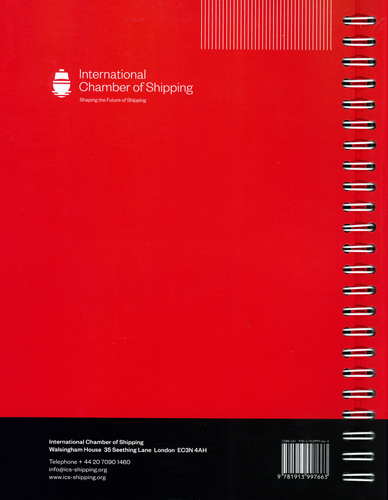Guide to Helicopter. Ship Operations/Руководство по взаимодействию вертолет-судно
Издание на английском языке
Ship design teams may find certain sections of this Guide of value, and many users may only need to access technical information in the Guide occasionally. The authors consider that retaining advice for both the helicopter and ship on joint operations in one publication is appropriate, and they anticipate that ship and helicopter operators alike will find this consistency useful.
Contents
Abbreviations
Definitions
Chapter 1 General guidance
1.1 Introduction
1.2 Selection of a helicopter operator
1.3 Provision of helicopter landing/operating area information
Chapter 2 Principles of operating safety
2.1 General principles
2.2 Marine responsibilities
2.2.1 Risk assessments
2.2.2 Helicopter operations risk assessment
2.2.3 Ship operator
2.2.4 Master
2.2.5 Responsible Officer (RO)
2.2.6 Deck crew
2.2.7 Administrator
2.2.8 Officer of the Watch (OOW)
2.2.9 Passengers
2.3 Aviation responsibilities
2.3.1 Helicopter operator
2.3.2 Helicopter pilot
2.3.3 Helicopter winch person/crew member
Chapter 3 Helicopter operating guidance
3.1 Introduction
3.2 Designation of helicopter performance
3.2.1 Performance Class 1
3.2.2 Performance Class 2
3.2.3 Performance Class 3
3.2.4 Performance for winching
3.3 The use of twin engine and single engine helicopters
3.4 Helicopter size and weight restrictions
3.5 Equipment and crewing
3.6 Helicopter landing gear
3.7 Weather and sea conditions
3.7.1 General
3.7.2 Wind conditions limiting helicopter operations
3.7.3 Sea and swell
3.7.4 Special conditions
Chapter 4 General ship requirements
4.1 Ship operating areas
4.1.1 Types of operating area
4.1.2 Location and size of operating area - Landing
4.1.3 Location and size of operating area - Winching
4.1.4 Poop deck platforms
4.1.5 Structural considerations (purpose built and non-purpose built landing areas)
4.2 Environmental effects
4.2.1 General considerations
4.2.2 Aerodynamic effects
4.2.3 Wave motion effects
4.3 Details of landing area
4.3.1 General guidance on markings
4.3.2 Markings for a landing area located at the ship’s side
4.3.3 Markings for amidships centreline landing area with or without restricted access from the ship’s side
4.4 Details of winching area
4.4.1 Positioning a winching area
4.4.2 Winching area on the bridge wing
4.4.3 Marking a winching area
4.5 Additional considerations for helicopter operating areas
4.6 Night operations: landing and winching area lighting
4.7 Firefighting appliances and rescue equipment
Chapter 5 Communications
5.1 Communications
5.1.1 General guidance
5.1.2 Communications equipment
5.2 Pre-arrival arrangements
5.2.1 Weather conditions
5.2.2 Departure of helicopter from the heliport
5.2.3 Pre-arrival checks
5.3 Navigation
5.3.1 Identification of the ship
5.3.2 Manoeuvrability
5.4 Signalling procedures
5.4.1 Ships’ international signals
5.4.2 Visual signals to helicopter
5.4.3 Loss of radio communications
5.4.4 Warning signal
Chapter 6 Operating procedures
6.1 Basic operating procedures
6.1.1 Officer of the Watch
6.1.2 Deck crew
6.1.3 Pre-arrival checks on the ship
6.1.4 Firefighting
6.1.5 The operating area
6.1.6 The helicopter
6.1.7 Emergency shutdown
6.2 Instructions to helicopter passengers
6.2.1 Passenger pre-flight briefing
6.2.2 Instructions
6.2.3 List of items prohibited for carriage in passengers’ baggage or on their person
6.3 Marine pilot transfer
6.4 Freight handling procedures
6.4.1 General freight handling
6.4.2 Carriage of dangerous goods
6.4.3 Carriage of freight and/or baggage in the passenger cabin with passengers
6.5 Helicopter landing and unloading
6.5.1 Landing
6.5.2 Disembarking passengers and freight from the helicopter
6.5.3 Operational safety
6.6 Helicopter hovering
6.6.1 Winching operations
6.6.2 Underslung loads
6.7 Helicopter loading and departure
6.7.1 Loading passengers and freight
6.7.2 Takeoff
6.7.3 Departing
Chapter 7 Bridge wing operations for marine pilot transfer
7.1 General
7.2 Background
7.3 Bridge wings
7.4 Threats and controls
7.4.1 Threats and general mitigating elements
7.4.2 Proximity of operations to command centre of ship
7.4.3 Varied size and form of bridge wing winching area
7.4.4 Elevation above sea level
7.4.5 Weather and sea conditions
7.4.6 Proximity to hot gases and other emissions from the funnel
7.4.7 Night operations
7.4.8 Ship/helicopter communication
7.4.9 Briefing of ship’s crew
7.4.10 Bridge wing winching clear zone markings
Chapter 8 Requirements specific to different ship types
8.1 Tankers
8.1.1 Oil tankers
8.1.2 Chemical/parcel tankers
8.1.3 Vapour dispersal
8.1.4 Vapour emission control
8.1.5 Safety
8.1.6 Freeboard
8.2 Bulk carriers and combination carriers
8.2.1 General
8.2.2 Geared bulk carriers
8.2.3 Gearless bulk carriers
8.3 Containerships
8.4 Gas carriers
8.4.1 Design limitations
8.4.2 Vapour emission control
8.5 General cargo ships
8.6 Passenger ships
8.7 Offshore operations
Chapter 9 Helicopter landing/operating area plan
9.1 Provision of helicopter landing/operating area plan
9.2 Helicopter landing/operating area plan
9.3 Completion of helicopter landing/operating area plan
9.4 Ship’s side helicopter landing/operating area plan
9.5 Centreline/amidships helicopter landing/operating area plan
9.6 ‘Winch only’ helicopter landing/operating area plan
Chapter 10 Emergency evacuation by air
10.1 General
10.2 Illness or injury evacuation
10.2.1 Requesting assistance
10.2.2 Preparation of patient
10.3 Emergency operating areas
Chapter 11 Helicopter incident/accident
11.1 General
11.2 Helicopter accident procedure
11.3 Fire procedures
11.4 Emergency procedures
11.4.1 Crash on deck
11.4.2 Emergency/precautionary landing
11.4.3 Crash on deck, major fuel spillage - no fire
11.4.4 Helicopter incident on landing
11.4.5 Man Overboard (MOB)
11.4.6 Helicopter ditching
11.5 Personnel in water
11.6 Plan of action
Appendices
Appendix A Commercial helicopters in marine use
Appendix B Communications
Appendix C Shipboard safety checklist for helicopter operations
Appendix D Instructions to helicopter passengers transferring to and from ships
Appendix E Helicopter landing/operating area plan
Appendix F Bridge wing winching-Model risk assessment matrix
Appendix G Relevant publications




